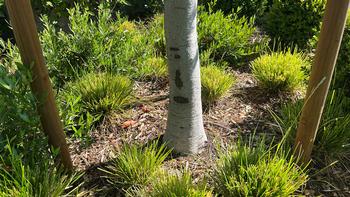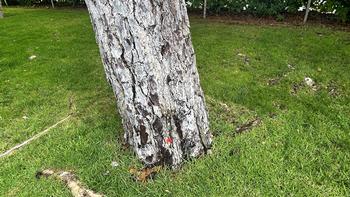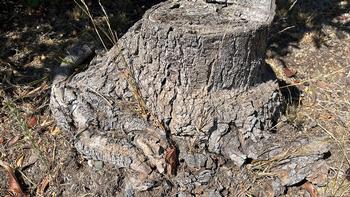Planting trees too deep, what could go wrong
-
James Campbell
-
When we bought our house 15 years ago, I was thrilled to see a newly planted persimmon tree in the front yard. I have waited and waited, and so far, our tree has produced only one fruit, and that was half eaten by birds when I discovered it. It turns out my tree had a very common problem. It was planted too deeply.
 This well planted tree shows the proper root flare at ground level. Photo: James Campbell
This well planted tree shows the proper root flare at ground level. Photo: James CampbellFall is one of the best times to think about planting new trees, particularly natives. It seems like the easiest thing in the world to do. You dig a hole and put the tree in it. But one of the most common calls that the Marin Master Gardener Help Desk gets is from folks who want to know why their young tree planted only a few years ago has never thrived and is dying. It is often determined (by inspection of the planted or uprooted tree) that it was planted too deep. It turns out there is a lot of precision required to plant a tree correctly.
My tree shows some telltale signs that a tree has been planted too deeply. It has struggled to grow and has never been very vigorous, with few and often discolored leaves. Persimmons should grow about one to two feet a year. Mine has grown about three feet in 15 years. I would see new growth in the spring, but then it would die back during the stress of summer. The biggest giveaway is that the root flare is not visible on the tree; it looks like a pencil stuck into the ground.
The root flare is the point where the woody tissue on the tree's main stem turns into roots. Although we may just see woody material, the stem and roots are different and have evolved to live in two different conditions. A tree should not look like a pencil stuck in the ground make certain the root flare is above soil level. Photo: James Campbell
A tree should not look like a pencil stuck in the ground make certain the root flare is above soil level. Photo: James CampbellRoots thrive in the warm moist conditions of the top two feet of soil where the most oxygen can be found. About 80 percent of the roots of a tree are in the top two feet of the ground. The roots are a vascular bundle of phloem and xylem surrounded by a cortex.
The tree stem is made up of concentric layers with a core of pith and heartwood surrounded by sapwood. Around this is a vascular cambium tissue that transports nutrients and water, and the whole is encased in a living inner and dead outer bark. The bark's job is to keep water in and to keep things that may attack the tree out.
When a young tree is planted too deeply, the thin young bark, which has not had the time to develop a thick outer bark, may deteriorate. Moist soil is full of bacteria and fungi that will eat away at the tree until it reaches and perhaps infects the vital cambium layer.
Another issue with trees planted too deeply is that roots grow horizontally or downwards. This results from a plant hormone in the roots called auxin, which bends roots in response to gravity in a process known as gravitropism. Since we know that most roots grow in the top 24 inches of the ground, every inch a tree is planted too deeply means reduced root spread in the soil with the most oxygen. As a result, roots don't grow upwards.
Girdling roots may be visible at ground level but are more likely to hide beneath the soil surface if caused by planting too deeply. Horizontal roots wrap around the tree's base and grow larger every year, restricting the flow of water and nutrients and weakening the tree over time. This tree succumbed to root girdling which is not always visible above ground. Photo: James Campbell
This tree succumbed to root girdling which is not always visible above ground. Photo: James CampbellTrees need healthy stems and healthy roots to thrive and survive. Planting a tree too deeply will shorten the tree's life expectancy. To learn more about the proper way to plant a tree, visit https://marinmg.ucanr.edu/CARE/PLANTING/. Remember the rules of Fire Safe Landscaping when planting trees. Use appropriate spacing ( especially on slopes), maintenance, and drought tolerance to help mitigate fire risk. Check out https://marinmg.ucanr.edu/BASICS/FIRESMARTLANDSCAPING/ for tips on Fire Safe Landscaping.



